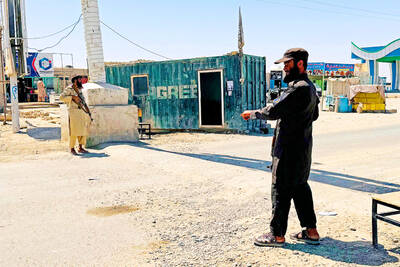The US might be aiming to put astronauts back on the moon, but for years it turned its back on crewed missions after the Columbia space shuttle disaster.
Its space program suffered a catastrophic setback when all seven astronauts were killed when the shuttle broke up while re-entering the Earth’s atmosphere 20 years ago on Feb. 1, 2003.
It was the second shuttle disaster after the Challenger explosion of 1986, which also killed the crew and led to sharp criticism of the safety culture at NASA.

Photo: AP
The shuttle fleet was grounded for more than two years, and the disaster sparked a major shift in US space flights.
Then-US president George W. Bush announced that the costly program would be retired.
For years after the last shuttle flight in 2011, NASA found itself dependent on Russia for transport to the International Space Station until Elon Musk’s Space X began flying passengers there in 2020.
As well as the moon, Washington is now preparing for a crewed mission to Mars, scheduled for the late 2030s or early 2040s.
Columbia broke up at 61,900m over eastern Texas and disappeared from radar screens at 9am, 16 minutes before it was due to land.
Flaming debris from the 80-tonne craft was caught streaking across the sky over the southern US by local TV stations, with parts scattered over Texas and Louisiana.
Bob Molter from Palestine, Texas, told National Public Radio how he saw the shuttle break up in the sky.
“There was a big boom that shook the house for more than a minute, and I went outside because I thought there had been a train accident on the nearby line,” he said. “I looked up and saw the trails of smoke zig-zagging, going across the sky.”
When Columbia took off on its 28th flight on Jan. 16, 2003, for a 16-day mission to carry out experiments, it had been in operation for over 20 years.
Flight STS-107 was launched under extremely tight security in the wake of the Sept. 11, 2001 attacks and also due to the presence on board of Israel’s first astronaut, Ilan Ramon.
A probe revealed that the shuttle disintegrated due to damage caused by a piece of foam from the external fuel tank that took a chunk out of the orbiter’s left wing during liftoff.
This left it unable to withstand the extreme temperatures generated by re-entry.
The shuttle program was born in 1972 under then-US president Richard Nixon, and went on to become a major focus of US human spaceflight ambitions over the next four decades.
The fleet served like space trucks, carrying more than 1,500 tonnes of equipment to help build the first space telescope, Hubble, and later the International Space Station.
The agency resumed shuttle flights in July 2005, continuing to fly missions to the space station until 2011.

‘EYE FOR AN EYE’: Two of the men were shot by a male relative of the victims, whose families turned down the opportunity to offer them amnesty, the Supreme Court said Four men were yesterday publicly executed in Afghanistan, the Supreme Court said, the highest number of executions to be carried out in one day since the Taliban’s return to power. The executions in three separate provinces brought to 10 the number of men publicly put to death since 2021, according to an Agence France-Presse tally. Public executions were common during the Taliban’s first rule from 1996 to 2001, with most of them carried out publicly in sports stadiums. Two men were shot around six or seven times by a male relative of the victims in front of spectators in Qala-i-Naw, the center

Canadian Prime Minister Mark Carney is leaning into his banking background as his country fights a trade war with the US, but his financial ties have also made him a target for conspiracy theories. Incorporating tropes familiar to followers of the far-right QAnon movement, conspiratorial social media posts about the Liberal leader have surged ahead of the country’s April 28 election. Posts range from false claims he recited a “satanic chant” at a campaign event to artificial intelligence (AI)-generated images of him in a pool with convicted sex offender Jeffrey Epstein. “He’s the ideal person to be targeted here, for sure, due to

Australia’s opposition party yesterday withdrew election promises to prevent public servants from working from home and to slash more than one in five federal public-sector jobs. Opposition leader Peter Dutton announced his conservative Liberal Party had dropped its pledge that public servants would be required to work in their offices five days a week except in exceptional circumstances. “I think we made a mistake in relation to this policy,” Dutton told Nine Network television. “I think it’s important that we say that and recognize it, and our intention was to make sure that where taxpayers are working hard and their money is

DISPUTE: Beijing seeks global support against Trump’s tariffs, but many governments remain hesitant to align, including India, ASEAN countries and Australia China is reaching out to other nations as the US layers on more tariffs, in what appears to be an attempt by Beijing to form a united front to compel Washington to retreat. Days into the effort, it is meeting only partial success from countries unwilling to ally with the main target of US President Donald Trump’s trade war. Facing the cratering of global markets, Trump on Wednesday backed off his tariffs on most nations for 90 days, saying countries were lining up to negotiate more favorable conditions. China has refused to seek talks, saying the US was insincere and that it